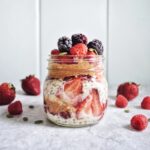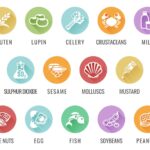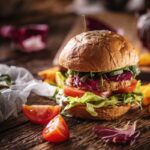Imagine a holiday feast brimming with vibrant colors and tantalizing aromas, yet completely free of common allergens. This isn’t a dream; it’s a delicious reality achievable with careful planning and creative culinary techniques. This guide unveils a treasure trove of festive, allergen-free recipes, transforming traditional holiday favorites into delectable dishes suitable for everyone, regardless of dietary restrictions. Prepare to be inspired by stunning visual presentations and the delightful simplicity of these allergy-conscious creations.
From adapting classic recipes with clever substitutions to crafting entirely new allergen-free masterpieces, we’ll explore a world of culinary possibilities. We’ll delve into the nutritional benefits of these dishes, showcasing the abundance of vitamins, minerals, and antioxidants that can grace your holiday table. Learn to plan a complete allergen-free menu, from appetizers to desserts, ensuring a balanced and flavorful experience for all your guests. This journey will equip you with the knowledge and confidence to create a truly inclusive and unforgettable holiday celebration.
Top 5 Allergen-Free Festive Dishes

This holiday season, delight your guests with delicious and safe allergen-free options. These festive dishes are naturally free from common allergens like dairy, gluten, nuts, and soy, ensuring everyone can enjoy the culinary delights of the season without worry. Each recipe prioritizes fresh, vibrant ingredients to create a memorable and healthy holiday spread.
Five Festive Allergen-Free Dishes
These five dishes offer a variety of flavors and textures, perfect for a diverse holiday gathering. Each recipe is designed to be both delicious and inclusive, catering to guests with various dietary restrictions.
| Dish | Ingredients | Preparation Time | Serving Suggestions |
|---|---|---|---|
| Roasted Turkey with Herb Butter (Dairy-Free) | Turkey breast, dairy-free herb butter (using olive oil, herbs, and spices), vegetables (carrots, celery, onions) | 3-4 hours (including roasting time) | Serve sliced with cranberry sauce and roasted vegetables. A side of gluten-free stuffing can also be added. |
| Sweet Potato Casserole (Dairy-Free, Gluten-Free, Nut-Free) | Sweet potatoes, maple syrup, coconut milk, spices (cinnamon, nutmeg), gluten-free breadcrumbs (optional) | 1 hour (including baking time) | Serve warm as a side dish. A dollop of dairy-free whipped cream (coconut cream) can be added as a garnish. |
| Cranberry Sauce (Naturally Allergen-Free) | Fresh cranberries, orange juice, maple syrup, spices (cinnamon, cloves) | 30 minutes (including cooking time) | Serve alongside the turkey or as a topping for gluten-free biscuits. |
| Green Bean Casserole (Dairy-Free, Gluten-Free, Nut-Free) | Green beans, mushroom broth, gluten-free flour, dairy-free milk (almond or coconut), onion, garlic, herbs | 45 minutes (including cooking time) | Serve warm as a side dish. Crispy fried onions (ensure allergen-free) can be added as a topping for added texture. |
| Pumpkin Pie (Dairy-Free, Gluten-Free, Nut-Free) | Pumpkin puree, coconut milk, maple syrup, spices (cinnamon, ginger, nutmeg), gluten-free pie crust (ensure allergen-free) | 1.5 hours (including baking time) | Serve chilled. A dollop of dairy-free whipped cream can be added for a festive touch. |
Nutritional Benefits of Allergen-Free Festive Dishes
These dishes offer a wealth of nutritional benefits. The roasted turkey provides lean protein and essential vitamins like niacin and selenium. Sweet potatoes are rich in vitamin A, fiber, and antioxidants. Cranberries are packed with vitamin C and antioxidants, boosting immunity. Green beans are a good source of vitamin K and fiber. Finally, pumpkin pie (with adjustments for allergens) provides vitamin A, potassium, and fiber. The use of maple syrup instead of refined sugar provides a natural sweetness and some minerals. Choosing dairy-free and gluten-free alternatives doesn’t compromise the nutritional value; instead, it often introduces additional benefits from ingredients like coconut milk and almond milk. For example, coconut milk offers healthy fats and various minerals.
Adapting Traditional Recipes for Allergen-Free Diets
Adapting beloved holiday recipes to accommodate common food allergies requires careful consideration of both taste and safety. Many traditional dishes rely on ingredients like dairy, eggs, nuts, and gluten, which are frequent allergens. Successfully modifying these recipes involves understanding the role each ingredient plays and finding suitable replacements that maintain the dish’s integrity. This process often requires experimentation and a willingness to adjust based on the results.
Modifying recipes for allergen-free diets presents unique challenges. Maintaining the original flavor profile and texture can be difficult, as certain ingredients provide crucial structural support or contribute significantly to the overall taste. For example, replacing eggs in a cake can alter its lightness and fluffiness, while substituting flour in a pie crust can impact its crispness. Careful ingredient selection and adjustments to cooking methods are crucial for achieving successful results.
Traditional Recipes and Their Allergen-Free Adaptations
The following three examples illustrate how traditional holiday recipes can be adapted for common food allergies. These modifications provide safe and delicious alternatives without compromising the festive spirit.
The modifications listed below provide step-by-step instructions for making each dish allergen-free. Each modification includes the original ingredient, the allergen-free substitute, and an explanation of the impact on taste and texture.
Allergen-Free Pumpkin Pie
Original Recipe: A classic pumpkin pie relies on a buttery crust and eggs for richness and structure. The filling typically includes dairy cream and sometimes even nuts for added flavor.
Allergen-Free Adaptation (Dairy-Free, Egg-Free, Nut-Free):
- Crust: Replace traditional butter with a vegan butter alternative (like Miyoko’s Kitchen Cultured Vegan Butter) and use a gluten-free flour blend (such as Bob’s Red Mill 1-to-1 Gluten-Free Baking Flour). This substitution slightly alters the texture, resulting in a slightly less flaky but still delicious crust. The flavor remains remarkably similar.
- Filling: Replace eggs with flax eggs (1 tablespoon ground flaxseed meal mixed with 3 tablespoons water per egg) for binding. Use full-fat coconut milk instead of dairy cream for richness and creaminess. The coconut milk adds a subtle sweetness and a slightly different texture compared to traditional cream, but the overall pumpkin pie flavor is maintained.
Allergen-Free Gingerbread Cookies
Original Recipe: Traditional gingerbread cookies often contain eggs, butter, and sometimes nuts in the dough.
Allergen-Free Adaptation (Dairy-Free, Egg-Free, Nut-Free):
- Dough: Replace butter with applesauce or vegan butter. Applesauce provides moisture and a slightly different texture, resulting in softer cookies. Vegan butter maintains a similar texture to traditional butter. Replace eggs with applesauce or mashed banana, which provides moisture and binding. This substitution slightly changes the texture, but the gingerbread flavor is not significantly affected.
- Glaze (Optional): Use a dairy-free glaze made with powdered sugar and plant-based milk (like almond or soy milk) for decoration. This maintains the sweet, festive glaze without the dairy.
Allergen-Free Stuffing
Original Recipe: Classic stuffing often includes bread, butter, eggs, and sometimes nuts or dairy-based broth.
Allergen-Free Adaptation (Gluten-Free, Dairy-Free, Nut-Free):
- Bread: Use gluten-free bread cubes made from a blend of gluten-free flours. This will result in a slightly different texture compared to traditional stuffing, but the flavor remains largely unaffected. Ensure the bread is completely dry before adding to the stuffing to prevent a soggy consistency.
- Fat: Replace butter with olive oil or a plant-based butter alternative for flavor and moisture. Olive oil adds a subtle fruity note, while vegan butter maintains a similar flavor to traditional butter.
- Broth: Use a vegetable broth instead of chicken broth to avoid potential hidden allergens. This does not affect the flavor significantly.
Step-by-Step Guide
Crafting an allergen-free cranberry sauce allows everyone to enjoy this festive staple, regardless of dietary restrictions. This recipe focuses on a simple, yet flavorful sauce, avoiding common allergens like nuts, dairy, and eggs. The vibrant color transformation and the shift in texture throughout the cooking process are key indicators of a perfectly cooked sauce.
Ingredients and Preparation
Begin by gathering your ingredients: 12 ounces of fresh cranberries, 1 cup of granulated sugar (or your preferred allergen-free sweetener), 1/2 cup of orange juice (freshly squeezed is best!), and 1/4 cup of water. Ensure all your utensils and containers are clean to prevent cross-contamination. Rinse the cranberries thoroughly under cold water to remove any debris.
Cooking the Cranberry Sauce
Place the cranberries, sugar, orange juice, and water in a medium-sized saucepan. Stir gently to combine. The initial mixture presents a vibrant mix of deep red cranberries, translucent orange juice, and glistening sugar crystals against the backdrop of the saucepan. Bring the mixture to a boil over medium-high heat. As the heat intensifies, the sugar begins to dissolve, creating a slightly syrupy liquid that coats the cranberries.
Simmering and Thickening
Once boiling, reduce the heat to low and simmer for approximately 10-15 minutes, or until the cranberries have popped and released their juices, creating a thickened sauce. During simmering, a remarkable transformation occurs. The cranberries, initially plump and firm, begin to burst, releasing their deep crimson juice. The sauce gradually thickens, changing from a watery consistency to a glossy, vibrant crimson. The color deepens, becoming richer and more intense as the cranberries break down. The texture changes from a loose mixture to a cohesive, slightly chunky sauce.
Finishing Touches and Consistency
Remove the saucepan from the heat. The sauce will continue to thicken slightly as it cools. At this stage, you can adjust the consistency to your liking. If you prefer a smoother sauce, use an immersion blender to gently puree a portion of the sauce. For a chunkier texture, leave it as is. Taste and adjust the sweetness if needed, adding a touch more sugar or orange juice depending on your preference. The final product is a rich, glossy cranberry sauce with a balanced sweetness and tartness, showcasing the vibrant color and appealing texture.
Cooling and Serving
Allow the cranberry sauce to cool completely before serving. This allows the flavors to meld and the sauce to thicken further. The cooled sauce takes on a more intense, jewel-toned red hue, its glossy surface reflecting light beautifully. It can be stored in an airtight container in the refrigerator for up to a week. This festive sauce is a perfect accompaniment to holiday meals, adding a burst of color and flavor to any plate.
Creating a joyful and inclusive holiday gathering, free from the anxieties of food allergies, is entirely within reach. This guide has provided a comprehensive toolkit – from adapting traditional recipes to crafting stunning allergen-free desserts – to ensure your holiday feast is both delicious and safe for everyone. By embracing creativity and attention to detail, you can transform your holiday table into a vibrant celebration of flavor and inclusivity, leaving lasting memories of a truly special occasion. The journey of creating allergen-free festive dishes is not just about avoiding allergens; it’s about embracing the opportunity to explore new flavors and culinary techniques, resulting in a richer and more meaningful holiday experience for all.
FAQ Summary
Can I freeze allergen-free dishes for later use?
Many allergen-free dishes freeze well. Consider freezing individual portions for easy reheating. Always label and date your containers.
How can I ensure cross-contamination doesn’t occur while preparing allergen-free dishes?
Use separate cutting boards, utensils, and cookware for allergen-free dishes. Thoroughly clean all surfaces before and after preparing food.
Where can I find allergen-free ingredients?
Many supermarkets have dedicated allergen-free sections. Health food stores and online retailers are also excellent resources.
What if a guest has a severe allergy? What precautions should I take?
Clearly label all dishes, indicating allergens present. Communicate with your guests beforehand about ingredients and potential cross-contamination risks. Have an emergency plan in place in case of a reaction.


